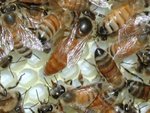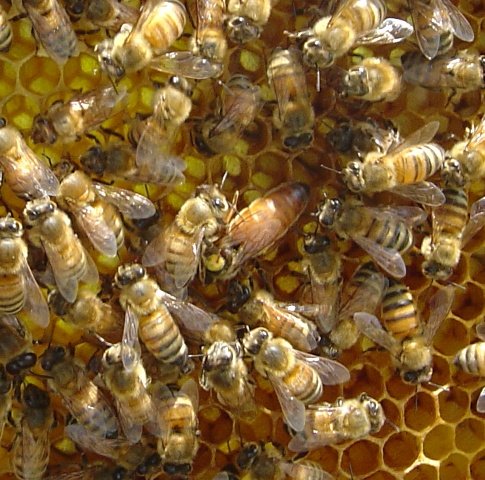.

.
Left: Making Bee Candy. All ingredients mixed in the pot on top of the stove.
.
.
.
.
.
.
That means they group together in a tight ball. By moving their wing muscles without moving their wings they generate heat to keep the inside of the cluster of bees between 80 and 90 degrees. The bees will remain in this cluster and slowly move around the hive in order to access the stores of honey which is their food.

.
.
Right: Heating the mixture to 245 degrees F.
Remember to hold it at this temperiture for 3
minutes.
..
.
.
.
.
If temperatures remain too low for too long a period of time then the bees can run out of food and starve to death only inches away from stored honey. To help them survive conditions where they cannot relocate to other areas containing food, beekeepers will often place candy above the bee cluster. This provides them with additional food stores in the event they run out of honey where they are clustered.
.

.
Left: Mixing the Candy in cool water. It is ready to pour out when it cools to 200 degrees F.
.
.
.
.
.
.
When temperatures manage to increase above 40 degrees the bees can break cluster and move around freely. They will take cleansing flights to rid themselves of the waste that they have been “holding in” all winter. Glad I’m not a bee!
.
 .
.Right: Harden candy in the cookie sheet
..
.
.
.
.
Since the temperature was above 40 degrees today I decided to open up the hives and check the status of the bee candy I had installed in the hives in late November. In fact, each of the hives had eaten all the bee candy in a four to five inch diameter area around the cluster.
.
.

Right: Hive being prepared for winter. Notice pest strips between the frames which need to be removed before winter. Additional items seen include menthal oil paper towels used for tracheal mite treatement, and sugar grease patty used for varroa mite treatement. After the pest strips are removed this hive will be ready for winter candy feed.
..
I installed additional candy as required in each of the hives.
Since it was warm enough, and I was disturbing the cluster of bees, they started their cleansing flights.
By the time I was done installing the bee candy I had brown drops of bee droppings all over me. Such are the hazards of beekeeping.
Here is my recipe for bee candy:
Ingredients:
5 lbs granulated cane sugar, 1 pint corn syrup, 1 & 1/3 cups water
Equipment:
Candy Thermometer, Cookie Sheet, Four oven mitts, Mixer, Sink with cold water
Directions:
1. Line the cookie sheet with wax paper and set aside on two oven mitts. Make sure the cookie sheet is level.
2. Take all ingredients and place in a pot. Mix until all ingredients are moist. Place on medium high heat. Place the candy thermometer on the side of the pot.
3. Heat the mixture until the temperature on the candy thermometer reads 245 degrees. Hold the mixture at that temperature for 3 minutes.
4. Turn off heat and immediately place the pot into the cool water (using the other two oven mitts). Use the mixer to mix the candy until the temperature drops to 200 degrees.
5. Pour mixture into the cookie sheet and allow the candy to harden and cool. While the candy is still warm make slices to form 8 or more squares.
6. Remove the candy from the cookie sheet and place pieces in the hives above the cluster of bees. Check monthly to see if more candy is needed.








No comments:
Post a Comment